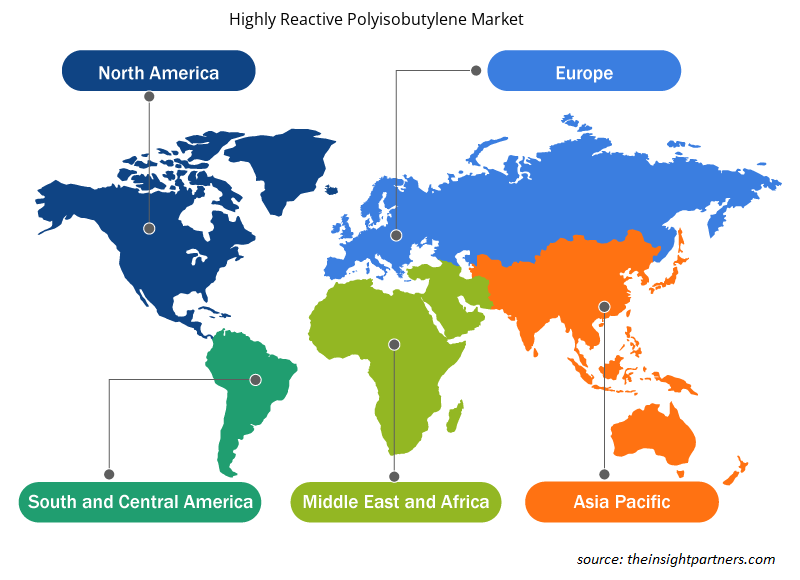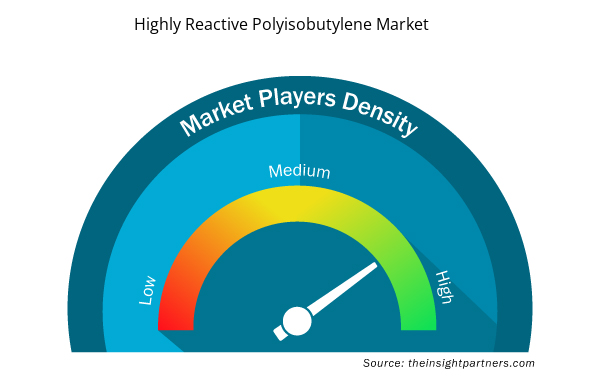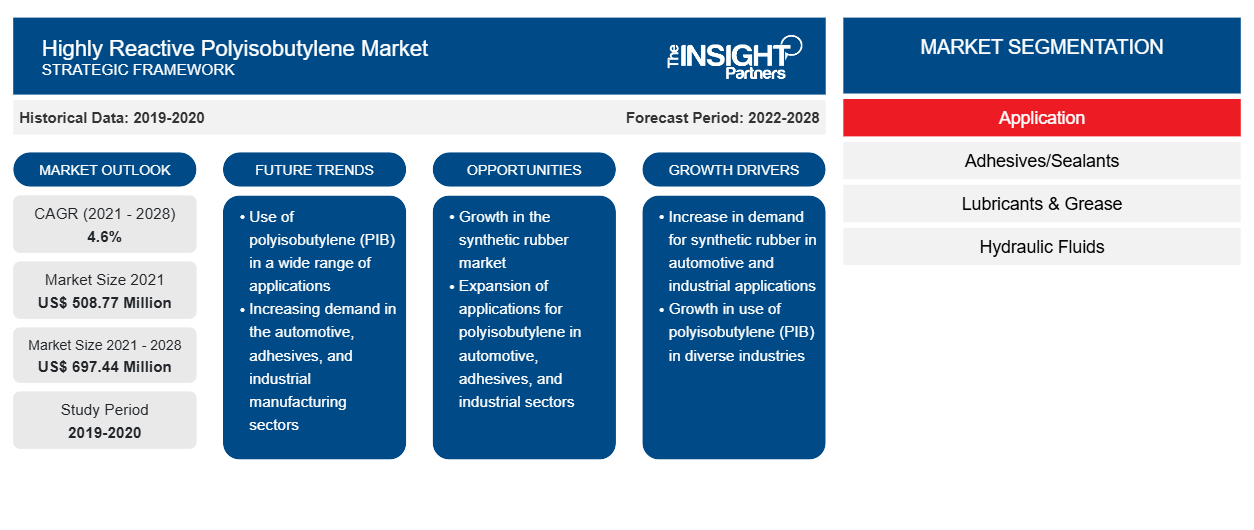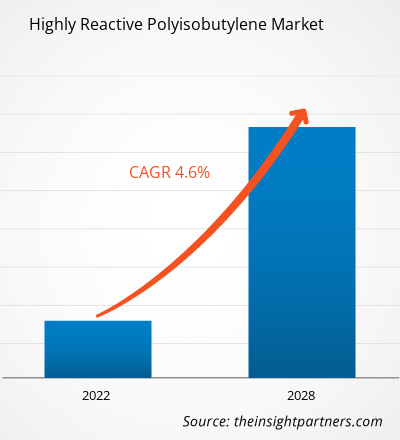من المتوقع أن يصل سوق البولي إيزوبوتيلين شديد التفاعل إلى 697.44 مليون دولار أمريكي بحلول عام 2028 من 508.77 مليون دولار أمريكي في عام 2021؛ ومن المتوقع أن ينمو بمعدل نمو سنوي مركب قدره 4.6٪ من عام 2021 إلى عام 2028.
يعد البولي إيزو بوتيلين شديد التفاعل ( HR-PIB ) وسيطًا مهمًا يستخدم في إنتاج إضافات الوقود ومواد التشحيم عالية الأداء، مثل المشتتات لزيوت المحرك أو منظفات الوقود. تسمح إضافات زيوت التشحيم عالية الأداء بتصميمات محركات أكثر كفاءة في استهلاك الوقود.
في عام 2020، استحوذت منطقة آسيا والمحيط الهادئ على أكبر حصة من الإيرادات في سوق البولي إيزو بوتيلين شديد التفاعل . يعد قطاع زيوت التشحيم والشحوم أكبر مستهلك لـ HR-PIB في منطقة آسيا والمحيط الهادئ. يعمل انتشار قطاع السيارات في المنطقة على تعزيز الطلب على السوائل الهيدروليكية ومواد التشحيم، وبالتالي دفع الحاجة إلى HR-PIB . علاوة على ذلك، فإن الزيادة في التصنيع والبناء في منطقة آسيا والمحيط الهادئ تدفع الطلب على الآلات والمعدات في مرافق التصنيع ذات الصلة.
قم بتخصيص هذا التقرير ليناسب متطلباتك
ستحصل على تخصيص لأي تقرير - مجانًا - بما في ذلك أجزاء من هذا التقرير، أو تحليل على مستوى الدولة، وحزمة بيانات Excel، بالإضافة إلى الاستفادة من العروض والخصومات الرائعة للشركات الناشئة والجامعات
- احصل على أهم اتجاهات السوق الرئيسية لهذا التقرير.ستتضمن هذه العينة المجانية تحليلاً للبيانات، بدءًا من اتجاهات السوق وحتى التقديرات والتوقعات.
تأثير جائحة كوفيد-19 على سوق البولي إيزو بوتيلين شديد التفاعل
في عام 2020، اضطرت العديد من الصناعات إلى إبطاء عملياتها بسبب الاضطرابات في سلاسل التوريد الناجمة عن إغلاق الحدود الوطنية والدولية، مما أدى إلى انخفاض الطلب على HR-PIB . تسبب الوباء في حدوث اضطرابات في عمليات التصنيع بسبب القيود التي فرضتها السلطات الحكومية في مختلف البلدان على عدد الموظفين في أرضيات العمل والنقل، مما جعل من الصعب على الموظفين التنقل من وإلى مواقع العمل. يجد HR-PIB تطبيقات رئيسية في تصنيع إضافات الوقود ومواد التشحيم عالية الأداء. أدى انخفاض الطلب على الوقود من مختلف الصناعات إلى إعاقة استهلاك إضافات الوقود، مما أعاق في النهاية مبيعات HR-PIB . ومع ذلك، مع بدء الاقتصادات في إحياء عملياتها في عام 2021، بدأ الطلب على HR-PIB أيضًا في الارتفاع تدريجيًا.
رؤى السوق
زيادة استخدام HR-PIB في إنتاج إضافات الوقود ومواد التشحيم عالية الأداء
يُعد HR-PIB وسيطًا مهمًا يستخدم في إنتاج إضافات الوقود ومواد التشحيم عالية الأداء . نظرًا لطبيعته شديدة التفاعل، فإنه يُفضل على البولي إيزو بوتيلين التقليدي في إنتاج الإضافات. تتمثل الوظيفة الرئيسية لإضافات مواد التشحيم في تحسين خصائص المخزون الأساسي في ظل ظروف تشغيل مختلفة. علاوة على ذلك، تدعم إضافات مواد التشحيم عالية الأداء تصميمات محركات أكثر كفاءة في استهلاك الوقود. المشتتات هي إضافات مواد تشحيم تساعد في منع تكوين الحمأة والورنيش وغيرها من الرواسب على الأسطح الحرجة. يتزايد الطلب على HR-PIB في التركيب الصناعي للمشتتات لزيوت محركات السيارات. إن وجود قواعد تصنيع مضافة قوية في الولايات المتحدة وأوروبا ومنطقة آسيا والمحيط الهادئ يجعلها مستهلكين رئيسيين لـ HR-PIB . وبالتالي، فإن الاستخدام المتزايد لـ HR-PIB في تصنيع إضافات الوقود ومواد التشحيم عالية الأداء يعزز نمو السوق.
رؤى التطبيق
بناءً على التطبيق، تم تقسيم سوق البولي إيزو بوتيلين شديد التفاعل إلى مواد لاصقة/مانعة للتسرب، ومواد تشحيم وشحوم، وسوائل هيدروليكية، وسوائل تشغيل المعادن، وغيرها. احتل قطاع مواد التشحيم والشحوم أكبر حصة سوقية في عام 2020. يتم استهلاك مواد التشحيم مثل زيوت المحرك وزيوت ناقل الحركة وزيوت التروس والشحوم وزيوت الضاغط بشكل كبير في صناعات السيارات والطائرات والبحرية والآلات. يساعد HR-PIB في تحسين الأداء العام لمواد التشحيم.
تعد مجموعة TPC ؛ وRB PRODUCTS INC.؛ وBASF PETRONAS Chemicals Sdn . Bhd ؛ وShandong Hongrui New Material Technology Co., Ltd؛ و Daelim Co., Ltd.؛ وChevron Corporation؛ وThe Lubrizol Corporation؛ وKEMAT Polybutenes ؛ و Weifang Binhai Petro-chem Co., Ltd.؛ وNelson Brothers Incorporated من بين اللاعبين الرئيسيين في سوق البولي إيزو بوتيلين شديد التفاعل . يركز اللاعبون العاملون في سوق البولي إيزو بوتيلين شديد التفاعل بشكل كبير على تطوير منتجات عالية الجودة ومبتكرة لتلبية متطلبات العملاء.
رؤى إقليمية حول سوق البولي إيزو بوتيلين شديد التفاعل
لقد قام المحللون في Insight Partners بشرح الاتجاهات والعوامل الإقليمية المؤثرة على سوق البولي إيزو بوتيلين عالي التفاعل طوال فترة التنبؤ بشكل شامل. يناقش هذا القسم أيضًا قطاعات سوق البولي إيزو بوتيلين عالي التفاعل والجغرافيا في جميع أنحاء أمريكا الشمالية وأوروبا ومنطقة آسيا والمحيط الهادئ والشرق الأوسط وأفريقيا وأمريكا الجنوبية والوسطى.

- احصل على البيانات الإقليمية المحددة لسوق البولي إيزو بوتيلين عالي التفاعل
نطاق تقرير سوق البولي إيزو بوتيلين شديد التفاعل
| سمة التقرير | تفاصيل |
|---|---|
| حجم السوق في عام 2021 | 508.77 مليون دولار أمريكي |
| حجم السوق بحلول عام 2028 | 697.44 مليون دولار أمريكي |
| معدل النمو السنوي المركب العالمي (2021 - 2028) | 4.6% |
| البيانات التاريخية | 2019-2020 |
| فترة التنبؤ | 2022-2028 |
| القطاعات المغطاة | حسب الطلب
|
| المناطق والدول المغطاة | أمريكا الشمالية
|
| قادة السوق وملفات تعريف الشركات الرئيسية |
|
كثافة اللاعبين في سوق البولي إيزو بوتيلين شديد التفاعل: فهم تأثيره على ديناميكيات الأعمال
يشهد سوق البولي إيزو بوتيلين عالي التفاعل نموًا سريعًا، مدفوعًا بالطلب المتزايد من المستخدم النهائي بسبب عوامل مثل تفضيلات المستهلكين المتطورة والتقدم التكنولوجي والوعي المتزايد بفوائد المنتج. ومع ارتفاع الطلب، تعمل الشركات على توسيع عروضها والابتكار لتلبية احتياجات المستهلكين والاستفادة من الاتجاهات الناشئة، مما يؤدي إلى زيادة نمو السوق.
تشير كثافة اللاعبين في السوق إلى توزيع الشركات أو المؤسسات العاملة في سوق أو صناعة معينة. وهي تشير إلى عدد المنافسين (اللاعبين في السوق) الموجودين في مساحة سوق معينة نسبة إلى حجمها أو قيمتها السوقية الإجمالية.
الشركات الرئيسية العاملة في سوق البولي إيزو بوتيلين عالي التفاعل هي:
- مجموعة تي بي سي
- شركة منتجات أر بي
- شركة باسف بيتروناس للمواد الكيميائية المحدودة
- شركة شاندونغ هونغروي لتكنولوجيا المواد الجديدة المحدودة
- شركة دايليم المحدودة
إخلاء المسؤولية : الشركات المذكورة أعلاه ليست مرتبة بأي ترتيب معين.

- احصل على نظرة عامة على أهم اللاعبين الرئيسيين في سوق البولي إيزو بوتيلين عالي التفاعل
تقرير يسلط الضوء على
- الاتجاهات التقدمية في صناعة البولي إيزو بوتيلين شديدة التفاعل لمساعدة اللاعبين على تطوير استراتيجيات فعالة طويلة الأجل
- استراتيجيات نمو الأعمال التي تتبناها الشركات لضمان النمو في الأسواق المتقدمة والنامية
- التحليل الكمي لسوق البولي إيزو بوتيلين عالي التفاعل من عام 2019 إلى عام 2028
- تقدير الطلب العالمي على HR-PIB
- تحليل القوى الخمس لبورتر لتوضيح فعالية المشترين والموردين العاملين في الصناعة
- التطورات الأخيرة لفهم سيناريو السوق التنافسي
- اتجاهات السوق وتوقعاتها والعوامل التي تدفع وتكبح نمو سوق البولي إيزو بوتيلين شديد التفاعل
- المساعدة في عملية اتخاذ القرار من خلال تسليط الضوء على استراتيجيات السوق التي تدعم المصلحة التجارية
- حجم سوق البولي إيزو بوتيلين شديد التفاعل في العقد المختلفة
- نظرة عامة مفصلة وتقسيم السوق وديناميكيات صناعة HR-PIB
- حجم سوق البولي إيزو بوتيلين شديد التفاعل في مناطق مختلفة مع فرص نمو واعدة
سوق البولي إيزو بوتيلين شديد التفاعل
طلب
- المواد اللاصقة/المواد المانعة للتسرب
- مواد التشحيم والشحوم
- السوائل الهيدروليكية
- سوائل تشغيل المعادن
- آحرون
نبذة عن الشركة
- مجموعة تي بي سي
- شركة منتجات أر بي
- شركة باسف بيتروناس للمواد الكيميائية المحدودة
- شركة شاندونغ هونغروي لتكنولوجيا المواد الجديدة المحدودة
- شركة دايليم المحدودة
- شركة شيفرون
- شركة لوبريزول
- كيمات بوليبوتينات
- شركة ويفانغ بينهاي للبتروكيماويات المحدودة
- شركة نيلسون براذرز
- التحليل التاريخي (سنتان)، السنة الأساسية، التوقعات (7 سنوات) مع معدل النمو السنوي المركب
- تحليل PEST و SWOT
- حجم السوق والقيمة / الحجم - عالميًا وإقليميًا وقطريًا
- الصناعة والمنافسة
- مجموعة بيانات Excel


- Bathroom Vanities Market
- Ketogenic Diet Market
- Maritime Analytics Market
- Passport Reader Market
- Underwater Connector Market
- Sleep Apnea Diagnostics Market
- Online Exam Proctoring Market
- Health Economics and Outcome Research (HEOR) Services Market
- Queue Management System Market
- Water Pipeline Leak Detection System Market

Report Coverage
Revenue forecast, Company Analysis, Industry landscape, Growth factors, and Trends

Segment Covered
This text is related
to segments covered.

Regional Scope
North America, Europe, Asia Pacific, Middle East & Africa, South & Central America

Country Scope
This text is related
to country scope.
الأسئلة الشائعة
Production techniques and catalysts used to synthesize HR-PIB have become an important subject for research and development activities in the last few decades. Research and development activities are mostly focusing on new polymerization techniques with greater potential advantages than traditional techniques. Various research groups are also actively investigating new catalysts for synthesizing highly reactive polyisobutylene; this further underlines the demand for different polymerization techniques than the existing ones. In addition, HR-PIB is gaining significant popularity in different downstream functionalization reactions due to its greater reactivity than its conventional counterparts. These factors are likely to lead to new future trends in the highly reactive polyisobutylene market.
Players operating in the highly reactive polyisobutylene market are increasingly focusing on ramping up their production capacities to meet future customer demands by making significant investments. They are implementing plans to set up additional capacities of highly reactive polyisobutylene. In 2019, Saudi Aramco and Total announced an agreement with Daelim, a South Korean petrochemical company, to build a new polyisobutylene facility. As per the Memorandum of Understanding (MoU) between these companies, Daelim is planning to build a new state-of-the-art PIB plant with a capacity of 80,000 tons. The new plant is expected to come on-stream in 2024. This specialty chemical project will be using Daelim’s PIB proprietary technology to produce a wide range of products, from conventional PIB (CPIB) to HR-PIB, in a single plant. Hence, the growing focus of market players to escalate their capacities of HR-PIB production will offer huge growth opportunities to the market players in the coming years.
Increasing use of highly reactive polyisobutylene in high-performance fuel and lubricant additive production and proliferation of the automotive sector are the key factors driving the highly reactive polyisobutylene market during the forecast period. Highly reactive polyisobutylene is an important intermediate that finds application in the production of high-performance fuel and lubricant additives, such as fuel detergents or dispersants for engine oils. Due to its highly reactive nature, highly reactive polyisobutylene is preferred over conventional polyisobutylene in additive production. The demand for highly reactive polyisobutylene is growing in the industrial synthesis of dispersants for automotive engine oils. Moreover, highly reactive polyisobutylene finds applications in the production of fuel and lubricant additives, sealants, adhesives, and greases, among others, the flourishment of the automotive sector, in turn, creates a high demand for the same, thereby boosting the market growth.
Based on application, the lubricant and grease segment led the global highly reactive polyisobutylene market in 2020. Lubricants such as engine oils, transmission oils, gear oils, greases, and compressor oils are highly consumed in automotive, aircraft, marine, and machinery industries. highly reactive polyisobutylene is used as an intermediate for lubricant additive manufacturing. It helps to enhance the overall performance of lubricant and grease which is propelling the segment growth.
The major players operating in the global highly reactive polyisobutylene market are TPC Group; RB PRODUCTS INC.; BASF PETRONAS Chemicals Sdn. Bhd; Shandong Hongrui New Material Technology Co., Ltd; Daelim Co., Ltd.; Chevron Corporation; The Lubrizol Corporation; KEMAT Polybutenes; Weifang Binhai Petro-chem Co., Ltd.; and Nelson Brothers Incorporated.
During the forecast period, Asia-Pacific is anticipated to account for the largest share of the global highly reactive polyisobutylene market. Asia-Pacific region comprises several developed and developing economies, including China, India, Japan, South Korea, among others. The region is experiencing significant growth in automotive, which is boosting the demand for hydraulic fluid and lubricants which directly boosts demand for highly reactive polyisobutylene. Further, the increase in industrialization and construction in the region is driving the demand of machineries and equipment for manufacturing facilities, hydraulic fluids and sealants are widely used in these industries.
Trends and growth analysis reports related to Chemicals and Materials : READ MORE..
The List of Companies - Highly Reactive Polyisobutylene Market
- TPC Group
- RB PRODUCTS INC.
- BASF PETRONAS Chemicals Sdn. Bhd
- Shandong Hongrui New Material Technology Co., Ltd
- Daelim Co., Ltd.
- Chevron Corporation
- The Lubrizol Corporation
- KEMAT Polybutenes
- Weifang Binhai Petro-chem Co., Ltd.
- Nelson Brothers Incorporated
The Insight Partners performs research in 4 major stages: Data Collection & Secondary Research, Primary Research, Data Analysis and Data Triangulation & Final Review.
- Data Collection and Secondary Research:
As a market research and consulting firm operating from a decade, we have published and advised several client across the globe. First step for any study will start with an assessment of currently available data and insights from existing reports. Further, historical and current market information is collected from Investor Presentations, Annual Reports, SEC Filings, etc., and other information related to company’s performance and market positioning are gathered from Paid Databases (Factiva, Hoovers, and Reuters) and various other publications available in public domain.
Several associations trade associates, technical forums, institutes, societies and organization are accessed to gain technical as well as market related insights through their publications such as research papers, blogs and press releases related to the studies are referred to get cues about the market. Further, white papers, journals, magazines, and other news articles published in last 3 years are scrutinized and analyzed to understand the current market trends.
- Primary Research:
The primarily interview analysis comprise of data obtained from industry participants interview and answers to survey questions gathered by in-house primary team.
For primary research, interviews are conducted with industry experts/CEOs/Marketing Managers/VPs/Subject Matter Experts from both demand and supply side to get a 360-degree view of the market. The primary team conducts several interviews based on the complexity of the markets to understand the various market trends and dynamics which makes research more credible and precise.
A typical research interview fulfils the following functions:
- Provides first-hand information on the market size, market trends, growth trends, competitive landscape, and outlook
- Validates and strengthens in-house secondary research findings
- Develops the analysis team’s expertise and market understanding
Primary research involves email interactions and telephone interviews for each market, category, segment, and sub-segment across geographies. The participants who typically take part in such a process include, but are not limited to:
- Industry participants: VPs, business development managers, market intelligence managers and national sales managers
- Outside experts: Valuation experts, research analysts and key opinion leaders specializing in the electronics and semiconductor industry.
Below is the breakup of our primary respondents by company, designation, and region:

Once we receive the confirmation from primary research sources or primary respondents, we finalize the base year market estimation and forecast the data as per the macroeconomic and microeconomic factors assessed during data collection.
- Data Analysis:
Once data is validated through both secondary as well as primary respondents, we finalize the market estimations by hypothesis formulation and factor analysis at regional and country level.
- Macro-Economic Factor Analysis:
We analyse macroeconomic indicators such the gross domestic product (GDP), increase in the demand for goods and services across industries, technological advancement, regional economic growth, governmental policies, the influence of COVID-19, PEST analysis, and other aspects. This analysis aids in setting benchmarks for various nations/regions and approximating market splits. Additionally, the general trend of the aforementioned components aid in determining the market's development possibilities.
- Country Level Data:
Various factors that are especially aligned to the country are taken into account to determine the market size for a certain area and country, including the presence of vendors, such as headquarters and offices, the country's GDP, demand patterns, and industry growth. To comprehend the market dynamics for the nation, a number of growth variables, inhibitors, application areas, and current market trends are researched. The aforementioned elements aid in determining the country's overall market's growth potential.
- Company Profile:
The “Table of Contents” is formulated by listing and analyzing more than 25 - 30 companies operating in the market ecosystem across geographies. However, we profile only 10 companies as a standard practice in our syndicate reports. These 10 companies comprise leading, emerging, and regional players. Nonetheless, our analysis is not restricted to the 10 listed companies, we also analyze other companies present in the market to develop a holistic view and understand the prevailing trends. The “Company Profiles” section in the report covers key facts, business description, products & services, financial information, SWOT analysis, and key developments. The financial information presented is extracted from the annual reports and official documents of the publicly listed companies. Upon collecting the information for the sections of respective companies, we verify them via various primary sources and then compile the data in respective company profiles. The company level information helps us in deriving the base number as well as in forecasting the market size.
- Developing Base Number:
Aggregation of sales statistics (2020-2022) and macro-economic factor, and other secondary and primary research insights are utilized to arrive at base number and related market shares for 2022. The data gaps are identified in this step and relevant market data is analyzed, collected from paid primary interviews or databases. On finalizing the base year market size, forecasts are developed on the basis of macro-economic, industry and market growth factors and company level analysis.
- Data Triangulation and Final Review:
The market findings and base year market size calculations are validated from supply as well as demand side. Demand side validations are based on macro-economic factor analysis and benchmarks for respective regions and countries. In case of supply side validations, revenues of major companies are estimated (in case not available) based on industry benchmark, approximate number of employees, product portfolio, and primary interviews revenues are gathered. Further revenue from target product/service segment is assessed to avoid overshooting of market statistics. In case of heavy deviations between supply and demand side values, all thes steps are repeated to achieve synchronization.
We follow an iterative model, wherein we share our research findings with Subject Matter Experts (SME’s) and Key Opinion Leaders (KOLs) until consensus view of the market is not formulated – this model negates any drastic deviation in the opinions of experts. Only validated and universally acceptable research findings are quoted in our reports.
We have important check points that we use to validate our research findings – which we call – data triangulation, where we validate the information, we generate from secondary sources with primary interviews and then we re-validate with our internal data bases and Subject matter experts. This comprehensive model enables us to deliver high quality, reliable data in shortest possible time.


 احصل على عينة مجانية لهذا التقرير
احصل على عينة مجانية لهذا التقرير